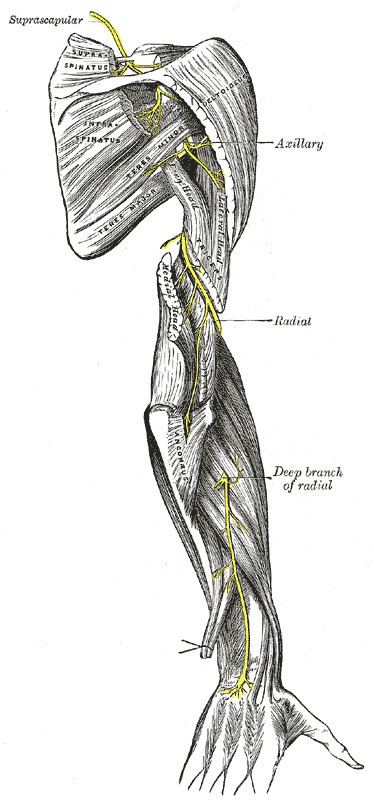Dorlands/Elsevier n_05/12566581 | Latin nervus radialis | |
 | ||
MeSH A08.800.800.720.050.700 | ||
The radial nerve is a nerve in the human body that supplies the posterior portion of the upper limb. It innervates the medial and lateral heads of the triceps brachii muscle of the arm, as well as all 12 muscles in the posterior osteofascial compartment of the forearm and the associated joints and overlying skin.
Contents
It originates from the brachial plexus, carrying fibers from the ventral roots of spinal nerves C5, C6, C7, C8 & T1.
The radial nerve and its branches provide motor innervation to the dorsal arm muscles (the triceps brachii and the anconeus) and the extrinsic extensors of the wrists and hands; it also provides cutaneous sensory innervation to most of the back of the hand, except for the back of the little finger and adjacent half of the ring finger (which are innervated by the ulnar nerve)
The radial nerve divides into a deep branch, which becomes the posterior interosseous nerve, and a superficial branch, which goes on to innervate the dorsum (back) of the hand.
Structure
The radial nerve originates as a terminal branch of the posterior cord of the brachial plexus. It goes through the arm, first in the posterior compartment of the arm, and later in the anterior compartment of the arm, and continues in the posterior compartment of the forearm.
In arm
From the brachial plexus, it travels posteriorly through what is often called the triangular interval (US), the lower triangular space of the axilla (UK) or the triceps hiatus.
Having passed through this inter muscular gap, the radial nerve continues posteriorly in a medial to lateral fashion on the arm while in conjunction with the deep artery of arm.
The nerve will first give off branches to the medial head of the triceps brachii and then enter a groove on the humerus, the radial sulcus (AKA spiral groove), where it innervates the lateral head of the triceps. It is commonly believed that the radial nerve also provided motor innervation to the long head of the triceps. However, a study conducted in 2004 determined that, in 20 cadaveric specimens and 15 surgical dissections on participants, the long head was innervated by a branch of the axillary nerve in all cases.
With the lateral and medial heads of the triceps innervated, the radial nerve emerges from the radial groove on the lateral aspect of the humerus.
At this point, it pierces the lateral intermuscular septum and enters the anterior compartment of the arm.
It then courses inferiorly between the brachialis and brachioradialis muscles.
When the radial nerve reaches the distal part of the humerus, it passes anteriorly to the lateral epicondyle and continues in the forearm.
In forearm
In the forearm, it branches into a superficial branch (primarily sensory) and a deep branch (primarily motor).
Function
The following are branches of the radial nerve (including the superficial branch of the radial nerve and the deep branch of the radial nerve/posterior interosseous nerve).
Cutaneous
Cutaneous innervation by the radial nerve is provided by the following nerve branches:
The superficial branch of the radial nerve provides sensory innervation to much of the back of the hand, including the web of skin between the thumb and index finger.
Motor
Muscular branches of the radial nerve:
Deep branch of the radial nerve:
Posterior interosseous nerve (a continuation of the deep branch after the supinator):
The radial nerve (and its deep branch) provides motor innervation to the muscles in the posterior compartment of the arm and forearm, which are mostly extensors.
Injury
Injury to the radial nerve at different levels causes different syndromes with varying motor and sensory deficits.
At the axilla
At mid-arm
Just below the elbow
Within the distal forearm:
